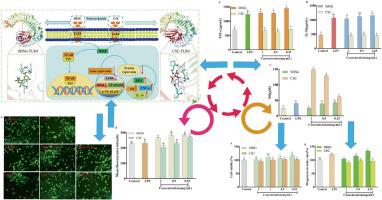当前位置:
X-MOL 学术
›
Int. J. Biol. Macromol.
›
论文详情
Our official English website, www.x-mol.net, welcomes your
feedback! (Note: you will need to create a separate account there.)
Sulfate glycosaminoglycan from swim bladder exerts immunomodulatory potential on macrophages via toll-like receptor 4 mediated NF-κB signaling pathways
International Journal of Biological Macromolecules ( IF 7.7 ) Pub Date : 2024-05-16 , DOI: 10.1016/j.ijbiomac.2024.132439
Kun Yang 1 , Xuejing Jia 1 , Jing Chen 1 , Zhuo Wang 1 , Bingbing Song 1 , Rui Li 1 , Kit-Leong Cheong 1 , Saiyi Zhong 2
International Journal of Biological Macromolecules ( IF 7.7 ) Pub Date : 2024-05-16 , DOI: 10.1016/j.ijbiomac.2024.132439
Kun Yang 1 , Xuejing Jia 1 , Jing Chen 1 , Zhuo Wang 1 , Bingbing Song 1 , Rui Li 1 , Kit-Leong Cheong 1 , Saiyi Zhong 2
Affiliation

|
This study explored the immunomodulatory impact and potential mechanisms on macrophages RAW264.7 using a purified macromolecular sulfate glycosaminoglycan (SBSG) from the swim bladder, whose structure was similar to chondroitin sulfate A. The results showed that SBSG at 0.25–1 mg/mL increased the viability and phagocytosis of RAW264.7 cells. Meanwhile, SBSG promoted the secretion of tumor necrosis factor α (TNF-α), interleukin 10 (IL-10), and nitric oxide (NO), as well as the production of reactive oxygen species (ROS). According to the RT-PCR and Western blot data, SBSG activated TLR4-nuclear factor kappa B (NF-κB) signaling pathways, which decreased the relative mRNA and protein levels of Toll-like receptor 4 (TLR4), IκB kinase β (IKKβ), NF-κB p65, and p-NF-κB p65. The molecular docking and molecular dynamic simulation findings revealed that the main binding force between TLR4 and SBSG was conventional hydrogen bond interaction, resulting in more stable ligand receptor complexes. In summary, SBSG exhibits significant immunomodulatory potential, similar to chondroitin sulfate C. The underlying molecular mechanism involved the binding of SBSG through hydrogen bonding to TLR4 receptors, triggering the NF-κB signaling pathway to downregulate the expression of related genes and proteins. This, in turn, regulated the secretion of various cytokines that were mediated by macrophages to exert the immunity of the body.
中文翻译:

来自鱼鳔的硫酸盐糖胺聚糖通过 toll 样受体 4 介导的 NF-κB 信号通路对巨噬细胞发挥免疫调节潜力
本研究使用从鱼鳔中纯化的大分子硫酸盐糖胺聚糖 (SBSG) 探讨了对巨噬细胞 RAW264.7 的免疫调节影响和潜在机制,其结构类似于硫酸软骨素 A。结果表明,0.25-1 mg/mL 的 SBSG 增加了 RAW264.7 细胞的活力和吞噬作用。同时,SBSG 促进肿瘤坏死因子 α (TNF-α) 、白细胞介素 10 (IL-10) 和一氧化氮 (NO) 的分泌,以及活性氧 (ROS) 的产生。根据 RT-PCR 和 Western blot 数据,SBSG 激活了 TLR4-核因子 kappa B (NF-κB) 信号通路,从而降低了 Toll 样受体 4 (TLR4) 、 IκB 激酶 β (IKKβ) 、 NF-κB p65 和 p-NF-κB p65 的相对 mRNA 和蛋白水平。分子对接和分子动力学模拟结果显示,TLR4 与 SBSG 之间的主要结合力是常规氢键相互作用,导致配体受体复合物更稳定。总之,SBSG 表现出显着的免疫调节潜力,类似于硫酸软骨素 C。潜在的分子机制涉及 SBSG 通过氢键与 TLR4 受体结合,触发 NF-κB 信号通路下调相关基因和蛋白的表达。这反过来又调节了由巨噬细胞介导的各种细胞因子的分泌,以发挥机体的免疫力。
更新日期:2024-05-16
中文翻译:

来自鱼鳔的硫酸盐糖胺聚糖通过 toll 样受体 4 介导的 NF-κB 信号通路对巨噬细胞发挥免疫调节潜力
本研究使用从鱼鳔中纯化的大分子硫酸盐糖胺聚糖 (SBSG) 探讨了对巨噬细胞 RAW264.7 的免疫调节影响和潜在机制,其结构类似于硫酸软骨素 A。结果表明,0.25-1 mg/mL 的 SBSG 增加了 RAW264.7 细胞的活力和吞噬作用。同时,SBSG 促进肿瘤坏死因子 α (TNF-α) 、白细胞介素 10 (IL-10) 和一氧化氮 (NO) 的分泌,以及活性氧 (ROS) 的产生。根据 RT-PCR 和 Western blot 数据,SBSG 激活了 TLR4-核因子 kappa B (NF-κB) 信号通路,从而降低了 Toll 样受体 4 (TLR4) 、 IκB 激酶 β (IKKβ) 、 NF-κB p65 和 p-NF-κB p65 的相对 mRNA 和蛋白水平。分子对接和分子动力学模拟结果显示,TLR4 与 SBSG 之间的主要结合力是常规氢键相互作用,导致配体受体复合物更稳定。总之,SBSG 表现出显着的免疫调节潜力,类似于硫酸软骨素 C。潜在的分子机制涉及 SBSG 通过氢键与 TLR4 受体结合,触发 NF-κB 信号通路下调相关基因和蛋白的表达。这反过来又调节了由巨噬细胞介导的各种细胞因子的分泌,以发挥机体的免疫力。

































 京公网安备 11010802027423号
京公网安备 11010802027423号